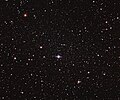Súbor:Carina Dwarf Galaxy.jpg

Veľkosť tohto náhľadu: 719 × 600 pixelov. Iné rozlíšenia: 288 × 240 pixelov | 576 × 480 pixelov | 921 × 768 pixelov | 1 228 × 1 024 pixelov | 2 456 × 2 048 pixelov | 3 771 × 3 145 pixelov .
Pôvodný súbor (3 771 × 3 145 pixelov, veľkosť súboru: 5,64 MB, MIME typ: image/jpeg)
História súboru
Po kliknutí na dátum/čas uvidíte ako súbor vyzeral vtedy.
| Dátum/Čas | Náhľad | Rozmery | Používateľ | Komentár | |
|---|---|---|---|---|---|
| aktuálna | 13:14, 24. február 2015 |  | 3 771 × 3 145 (5,64 MB) | FDMS4 | Reverted to version as of 14:03, 28 June 2011. |
| 03:00, 24. február 2015 |  | 3 768 × 3 144 (5,78 MB) | SteinsplitterBot | Bot: Image rotated by 180° | |
| 14:03, 28. jún 2011 |  | 3 771 × 3 145 (5,64 MB) | Jmencisom |
Použitie súboru
Na tento súbor odkazujú nasledujúce 2 stránky:
Globálne využitie súborov
Nasledovné ďalšie wiki používajú tento súbor:
- Použitie na af.wikipedia.org
- Použitie na ar.wikipedia.org
- Použitie na ast.wikipedia.org
- Použitie na ca.wikipedia.org
- Použitie na de.wikipedia.org
- Použitie na el.wikipedia.org
- Použitie na en.wikipedia.org
- Použitie na es.wikipedia.org
- Použitie na fi.wikipedia.org
- Použitie na fr.wikipedia.org
- Použitie na he.wikipedia.org
- Použitie na id.wikipedia.org
- Použitie na it.wikipedia.org
- Použitie na ja.wikipedia.org
- Použitie na ko.wikipedia.org
- Použitie na mk.wikipedia.org
- Použitie na nl.wikipedia.org
- Použitie na no.wikipedia.org
- Použitie na pl.wikipedia.org
- Použitie na pt.wikipedia.org
- Použitie na ro.wikipedia.org
- Použitie na ru.wikipedia.org
- Použitie na si.wikipedia.org
- Použitie na tr.wikipedia.org
- Použitie na uk.wikipedia.org
- Použitie na vi.wikipedia.org
- Použitie na www.wikidata.org